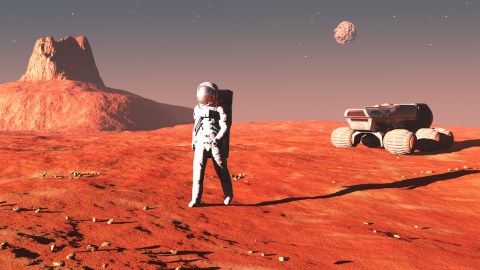Buzz Aldrin’s Out of This World Martian Technologies

Nobody said putting a man or woman on the surface of Mars was going to be easy. As NASA astronaut Buzz Aldrin explains in his new book, Mission to Mars, it’s going to require an extraordinary number of out-of-this-world technologies to make it happen — everything from advanced robotic surface rovers to in situ resource utilization (i.e. terraforming) to interplanetary spaceships connected by space taxis. Calling it his Unified Space Vision, Aldrin suggests a scenario for 2035, in which the U.S. is finally sending humans to Mars and returning them safely to Earth. It’s not a one-and-done (like Aldrin’s Apollo lunar mission), though: What Aldrin has in mind is a coherent, stepwise strategy for the establishment of permanent human settlements on Mars.
To make it all happen on schedule, it’s going to need a few out-of-this-world technologies.
The central piece in Aldrin’s strategy for a Mission to Mars is what he calls “The Aldrin Mars Cycler” (and, at other times, the “Aldrin Cycler” and the “Purdue/Aldrin Cycler”). As Aldrin sees it, any strategy for getting humans to Mars will require a version of interplanetary cruise ships that perpetually cycle between the Earth, the moon and Mars, picking up astronauts and supplies, and dropping off what’s needed for building out future Martian settlements. Thanks to the gravitational effects of these orbits, these Cyclers could make a round-trip between Earth and Mars in just under 3 years. What makes the Cyclers so valuable, from Aldrin’s perspective, is that they represent a major break from the Apollo thinking of the moon exploration days — instead of modular spacecraft that are used up and thrown away, the Mars strategy would call for the same spacecraft making regular cycles between Earth and Mars.
Of course, that’s easier said than done. Cyclers would require “space taxis” ferrying astronauts to and from the Cyclers at regular intervals and at extremely fast speeds. (Aldrin likens it to running to catch up to a bus going at 50 mph) And, given the 3-year mission duration, these spacecraft would have to have advanced radiation shielding as well – not to mention the ability to produce (and recycle) almost everything aboard the spaceship.
And that’s just the warm-up.
The staging point for a mission to the Martian surface would actually be one of the two moons circling the Red Planet – Phobos or Deimos. From a space physics gravitational perspective, it’s just easier to land on these tiny moons than on Mars. Once on Phobos or Deimos, astronauts would be able to make use of telerobotic equipment to explore the surface and examine the Martian atmosphere. Given the relatively tiny distance beween these moons and Mars (approximately 4,000 miles), astronauts would have near-real-time control over the robots. Contrast that to the current situation, where the communication time lag between NASA on Earth and Curiosity on Mars is anywhere from 4 minutes to 22 minutes, depending on the relative positioning of Earth and Mars in their orbits.
And it’s not just your garden-variety Curiosity rovers, either, that Buzz Aldrin thinks could be exploring the surface of Mars by 2035. There will be drone-like aircraft (ARES robotic airplanes) that glide through the Martian sky, nuclear-powered “hoppers” that range freely across the surface of Mars, and snake-like vehicles that slither across the surface, rappel huge cliffs and peer into craters. There will also be the THOR blasters – robotic machines that gather soil samples and search for hidden water by blasting the surface with projectiles at extreme force. (We may come in peace, but we also reserve the right to blast the heck out of your planet!)
These blasters, gliders and slithering snakes are not just gathering data about Mars – they will also help to terraform the Martian surface for future human habitation. One fundamental goal of the Mars exploration, writes Aldrin, should be a permanent Mars colony — what Aldrin refers to as a strategy of “Deposit, No Return.” This will require the use of giant, inflatable habitation modules – “space habs” – that astronauts can inflate once they arrive on the Martian surface. It might also require the creation of Buckminister Fuller-inspired geodesic domes that provide climate-controlled living spaces for plants and humans. These domes would be powered by nuclear power plants, solar power systems or, yes, wind turbines.
If all this sounds a bit fantastical, maybe it is. At times, Aldrin’s Mission to Mars sounds like a grab-bag of futuristic technologies supported by a lot of sketches on the back of NASA cocktail napkins.
However, there are actually more people studying how to get to Mars than you might think – everyone from NASA (which is setting up its InSight mission for 2016) to Elon Musk and his Red Dragon concept to commercial ventures from the likes of Lockheed Martin (i.e. Project Red Rocks). And, of course, there are international rivals like China and Russia that are also taking a closer look at the Red Planet. In fact, Russia has already plotted possible landing destinations on Phobos.
What’s needed now in the United States is not just a vague mission statement like we had in the heady Apollo days of space exploration – something along the lines of “fly me to Mars and back” – but a Unified Space Vision that takes into account how all of the moving pieces (and there are a lot of them) actually fit together to make a permanent human colony on Mars a reality. Everything from commercial space flights to asteroid mining missions to international lunar missions need to be coordinated and sync up as part of a broader Mars strategy. If we’re really going to get to the Red Planet by 2035, we need to start planning and executing now, while the momentum from Curiosity is still strong enough to help us overcome the gravitational effects of Congressional inertia.
image: Scene of Astronaut on Mars / Shutterstock




